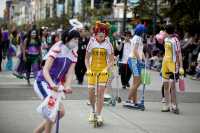
31 Oct Really Scary! Pediatric Pedestrian Fatalities 10x Higher on Halloween
MedicalResearch.com Interview with:
 Dr. John A. Staples, MD
Dr. John A. Staples, MD
Clinical Assistant Professor
University of British Columbia
MedicalResearch.com: What is the background for this study? What are the main findings?
Response: At this time last year, my co-author Candace Yip and I noticed an impressive number of advertisements for Halloween-themed parties at bars taped to lamp-posts. We wondered if the combination of dark costumes, dark evenings, alcohol and trick-or-treaters made the streets more dangerous for pedestrians.
To see if our hunch was correct, we examined 42 years of data on all fatal vehicle crashes in the United States between 1975 and 2016. We compared the number of pedestrian fatalities between 5 p.m. and midnight on Halloween with the number during the same hours on control days one week earlier and one week later. We found that 14 pedestrian deaths occurred on the average Halloween, while only 10 pedestrian deaths occurred on the average control evening. This corresponded to a 43% increase in the relative risk of pedestrian fatality on Halloween.
Among children aged 4 to 8 years of age, the risk of death was ten times higher on Halloween evening compared to control evenings. Risks were highest around 6pm, which is prime trick-or-treating time. Absolute risks were small and declined throughout the four decades of the study, but the relative risk increase on Halloween persisted throughout the entire study interval.
MedicalResearch.com: What should readers take away from your report?
Response: We think this study highlights the need to make the streets safe for pedestrians on Halloween. We also think it highlights the need to make streets safe for pedestrians on the other 364 days of the year. On any given evening, the only acceptable number of pedestrian fatalities is zero. We hope our findings prompt politicians, policymakers, drivers, parents and pedestrians to work together to make the streets safer for pedestrians year-round.
MedicalResearch.com: What recommendations do you have for future research as a result of this work?
Response: We need a better understanding of how cities can be designed to be safe for pedestrians, cyclists, children and other vulnerable road users. We need to improve our understanding of what steps residents can take to improve pedestrian safety in their neighborhood.
MedicalResearch.com: Is there anything else you would like to add?
Response: We hope parents will consider working with their neighborhood association to make their neighborhood car-free on Halloween. We hope that parents will encourage kids to be visible when trick-or-treating, perhaps by attaching reflective patches to their costumes or by having them carry lights. We also want parents to review safe street-crossing behaviors with their kids and to supervise younger trick-or-treater.
We suggest that trick-or-treaters of all ages stay on sidewalks, minimize road crossings, and look both ways before crossing the street.
Finally, we want to remind all adults not to drive if they’ve consumed any alcohol, cannabis, or other drugs. We want drivers to slow way down in residential areas and to be particularly vigilant when entering and exiting driveways or alleys.
We want everyone to stay safe and have a fun Halloween!
We have no disclosures.
Citation:
[wysija_form id=”3″]
[last-modified]
The information on MedicalResearch.com is provided for educational purposes only, and is in no way intended to diagnose, cure, or treat any medical or other condition. Always seek the advice of your physician or other qualified health and ask your doctor any questions you may have regarding a medical condition. In addition to all other limitations and disclaimers in this agreement, service provider and its third party providers disclaim any liability or loss in connection with the content provided on this website.
Last Updated on October 31, 2018 by Marie Benz MD FAAD
